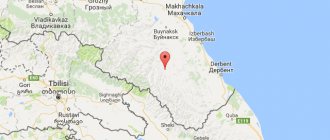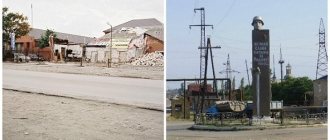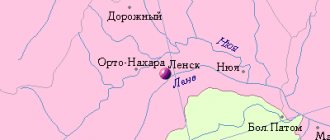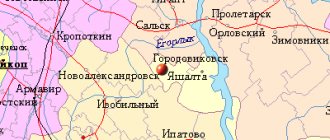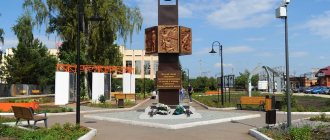City in Dagestan, Russia
| Dagestan Lights Dagestan Lights | |
| Town | |
| Flag Coat of arms | |
| Location Dagestan Lights | |
| Dagestan Lights Location Dagestan Lights Show map of Russia Dagestan Lights Dagestan Lights (Republic of Dagestan) Show map of the Republic of Dagestan | |
| Coordinates: 42°07′N 48°11'E / 42.117°N W. 48.183°E / 42.117; 48.183Coordinates: 42°07′N 48°11'E / 42.117°N W. 48.183°E / 42.117; 48.183 | |
| A country | Russia |
| Federal subject | Dagestan |
| Height | 35 m (115 ft) |
| population (2010 Census)[1] | |
| • General | 27,923 |
| • Evaluate (2018)[2] | 29,401 (+5.3%) |
| Administrative status | |
| • Subordinate | Town of Dagestan Lights[3] |
| • Capital from | Town of Dagestan Lights[3] |
| Municipal status | |
| • Urban district | City district Dagestan Lights[4] |
| • Capital from | City district Dagestan Lights[4] |
| Timezone | UTC + 3 (MSK [5]) |
| Postal code(s)[6] | 368670 |
| OKTMO I WOULD | 82708000001 |
Dagestan Lights
(Russian: Dagestanskie Ogni [dəgʲɪˈstanskɪɪ ɐˈgnʲi]; Lezgin: Dagustandin TsӀayar) is a town in the Republic of Dagestan, Russia, located on the coast of the Caspian Sea, 120 km (75 mi) south of Makhachkala. Population: 27,923 (2010 Census);[1]26,346 (2002 Census);[7]21,676 (1989 Census).[8]
Climate
Dagestan Ogni has a cold semi-arid climate (Köppen climate classification: BSk
).
| Climate data for Dagestan Ogni | |||||||||||||
| Month | Jan | Feb | Mar | Apr | May | Jun | Jul | Aug | Sep | October | But I | December | Year |
| Average high °C (°F) | 4.5 (40.1) | 4.9 (40.8) | 7.9 (46.2) | 14.2 (57.6) | 20.5 (68.9) | 26.2 (79.2) | 29.3 (84.7) | 28.7 (83.7) | 24.4 (75.9) | 18.4 (65.1) | 11.7 (53.1) | 7.3 (45.1) | 16.5 (61.7) |
| Daily average °C (°F) | 1.1 (34.0) | 1.7 (35.1) | 4.5 (40.1) | 9.8 (49.6) | 16.2 (61.2) | 21.6 (70.9) | 24.8 (76.6) | 24.6 (76.3) | 20.1 (68.2) | 14.5 (58.1) | 8.4 (47.1) | 4.1 (39.4) | 12.6 (54.7) |
| Average low °C (°F) | −2.3 (27.9) | −1.4 (29.5) | 1.1 (34.0) | 5.4 (41.7) | 11.9 (53.4) | 17.0 (62.6) | 20.3 (68.5) | 20.5 (68.9) | 15.8 (60.4) | 10.6 (51.1) | 5.1 (41.2) | 0.9 (33.6) | 8.7 (47.7) |
| Average precipitation mm (inches) | 25 (1.0) | 34 (1.3) | 24 (0.9) | 23 (0.9) | 31 (1.2) | 22 (0.9) | 24 (0.9) | 24 (0.9) | 43 (1.7) | 51 (2.0) | 35 (1.4) | 37 (1.5) | 373 (14.6) |
| Source: Climate-Data.org [10] | |||||||||||||
Recommendations
Notes
- ^ a b
Federal State Statistics Service of Russia (2011).
“All-Russian Population Census 2010. Volume 1" [All-Russian Population Census 2010, vol. 1]. All-Russian Population Census 2010 [All-Russian Population Census 2010]
(in Russian). Federal State Statistics Service. - "26. The size of the permanent population of the Russian Federation by municipalities as of January 1, 2022.” Federal State Statistics Service. Retrieved January 23, 2022.
- ^ a b c
Law No. 16. - ^ a b c
Law No. 6. - "On the calculation of time." Official Internet portal of legal information
(in Russian). June 3, 2011. Retrieved January 19, 2022. - Post office. Information and computing center of OASU RPO. ( Post office
).
Search for postal facilities ( Search for postal facilities
) (in Russian) - Federal State Statistics Service of Russia (May 21, 2004). > [Population of Russia, its federal districts, federal subjects, districts, urban settlements, rural settlements - administrative centers, rural settlements with a population of more than 3000 people] (XLS). All-Russian Population Census of 2002 [All-Russian Population Census of 2002]
(in Russian). - “All-Union Population Census of 1989. The actual population of union and autonomous republics, autonomous regions and districts, territories, regions, urban settlements and villages. Dagestanskaya Pravda”, No. 81, April 12, 2002 (People's Assembly of the Republic of Dagestan. Law No. 16 dated April 10, 2002 On the administrative-territorial structure of the Republic of Dagestan
As amended by Law No. 106 of December 30, 2013
On amendments to various legislative acts of the Republic of Dagestan
... Valid from the date of official publication.). - People's Assembly of the Republic of Dagestan. Law No. 6 of January 13, 2005 “On the status and boundaries of municipalities of the Republic of Dagestan,” as amended. Law No. 43 of April 30, 2015 “On the status of an urban district with an intra-city division” City of Makhachkala “, the status and boundaries of intra-city districts within an urban district with an intra-city division” City of Makhachkala “and on amendments to certain acts of the Republic of Dagestan”. Came into force on the date of official publication. Published: “Dagestanskaya Pravda”, No. 8, February 15, 2005 (People's Assembly of the Republic of Dagestan. Law No. 6 of January 13, 2005 On the status and boundaries of municipalities of the Republic of Dagestan
As amended by Law No. 43 of April 30, 2015
About the status of the urban district "City of Makhachkala" with intracity divisions, the status and boundaries of intracity districts, which include the urban district "City of Makhachkala" with intracity divisions, and on amendments to various legislative acts of the Republic of Dagestan
. Valid from the date of official publication.).
DAGESTAN LIGHTS The joys and sorrows of a single-industry town
This small city (about 30 thousand population), located near Derbent, was founded in 1914. That is, this year is the anniversary year of the Lights - 105 years. After the earthquake that occurred here in 1904, natural gas began to seep through cracks in the rocks. It caught fire, a red flame soared above the ground, hence the poetic name given to the city that arose on this site a decade after the earthquake.
Or rather, there was no city as such in those days, there was a village that grew up around a glass factory built by Russian entrepreneurs, the Malyshev brothers. The plant operated on the very same natural gas gushing from underground; such production had not yet existed in those years either in Russia or in Europe. And the raw material – quartz sand – was found nearby. Today this glass factory, which has undergone both destruction and restoration over the years of its existence, remains the city-forming one and, in fact, the only one operating in Ogni.
Last year, when I was in these parts for the first time, I tried to get into the territory of the plant, but was stopped by a vigilant watchwoman, an elderly Russian woman, sorry, I forgot her name. She carried out her duties clearly, but she was friendly with the uninvited guest, she said that she had lived in the city since her youth, and that Dagestan Lights was the best place on earth. Like this.
This summer I came here again, walked the streets, talked to people. With my main interlocutor, Zubairat, a native of these places, we talked a lot, including about Russians, who once made up more than half of the local population (now they make up 1%).
It is clear that the first specialists who came here to master glass production were from Russia. And only then local residents from mountain villages began to come to Ogni in search of work.
“A lot of Russians left in the 90s,” says Zubairat. - I do not know why. Nobody offended them, we all lived here together, worked side by side, my brother, for example, had many Russian friends. It's a shame we left. They were good people, fair, we had a good time with them.”
Yes, people with Slavic appearance are rare here today, but Russian is still the main language of communication in this multinational city. And the Russian cemetery, located in the very center, looks well-groomed and clean, despite the fact that the relatives of most of those who lie there now live thousands of kilometers from Ogni.
By the way, about cleanliness. Garbage along the roadsides, a lot of spontaneous landfills - this is what spoils the impression of the city. The problem is all-Russian, but here it’s just a disaster. And the reason, I am sure, is not only that municipal services are not being improved, but also in the residents themselves, who sincerely love their city. Paradox!
So Zubairat spoke about the Lights with tenderness: about how good people live here, that the city is calm, recently they have begun to patch up roads in some places, a new district has appeared - Cheryomushki, where beautiful houses have been built, playgrounds have been built, even a circus sometimes she comes to the city, performs in the square... However, the past for her, who has lived here for half a century, is brighter and kinder, or something. And there is a lot of objectivity in this, and not just longing for one’s younger years.
“Since my childhood,” says Zubairat, “there have been a lot of houses in the city, but little greenery, very little. Even the territory of the park was greatly reduced; the land was distributed for the construction of shops. And before it was so nice and cultural here, people came and relaxed. Now the park is almost gone. So many trees were destroyed to set up these stores! Every owner should be required to plant at least one tree near his outlet. I want the eye to be happy, I want to be proud of the city! It’s located very well for us: on one side there are mountains, on the other there is the sea, but we don’t even have a proper beach, just sand and garbage... But the main thing is that working in Ogni is very difficult now. Young people study, acquire different professions, but have nowhere to work. There is only one glass factory in the city, and then there are shops and shops. That's why many people leave. During the USSR, the plant also had workshops producing window glass and various figured gift items made of glass (now you can admire them in the city Museum - Note), they were closed during perestroika, people were fired. Now the plant produces only glass jars, and, of course, there are not enough jobs. The people have changed too. You pass by and all they talk about is money...”
Zubairat sighs. Her son was also forced to leave for Moscow to earn money.
The men we were able to talk to preferred to discuss the state of affairs in the republic as a whole. They praised Vladimir Vasiliev, who had been leading Dagestan for two years, and were worried that there were rumors that they wanted to take him to Moscow, but he had only just begun to restore order. How good, they repeated with one voice that in the republic many traffic police posts are now on duty with officers seconded from the central regions of Russia, Russians, basically, they do everything according to the law, do not abuse power and are generally polite. And all my interlocutors (there were five of them) sighed for Soviet times, and not only pensioners, but also young people who did not live in those days.
Collective farms recalled that during perestroika they were destroyed, vineyards were cut down, and that then there was no need to worry about the future of children, not like now...
DAGESTAN LIGHTS
But let me return to the Dagestan Lights - to what new times brought to the city. New mosques have appeared. In her youth, Zubairat was alone, but now there are five. Arabic language courses have been opened at mosques, which are attended by both children and adults; people are drawn to faith and want to read the Koran in the language in which the holy book was written. Even women take these courses.
By the way, many Muslim women in the Lights began to, as Zubairat put it, cover themselves up - wear long dresses and cover their heads with scarves. And they wear hijabs.
“One day, my brother, who came from Moscow,” recalls Zubairat, “came home and said: “I just saw two girls, one in a hijab, and the other with her navel open, walking and chatting merrily. I wonder what?” And he laughed."
I also saw similar pictures on the streets of the good-natured, “tolerant” and cozy (if only the garbage was removed) city of Dagestan Lights. Where, by the way, despite all the problems, according to the census, the population is growing, and where many children are again being born into families. Until recently, people did not dare to do this. So, life, albeit slowly, is getting better?
PS . I want to please Zubairat and all the Ognevites who are not aware of the grandiose plans to transform their city, which was included in the federal program for the development of single-industry towns. According to the program, a paper and cardboard production plant will be built in Ogni, as well as a large greenhouse complex, which will provide jobs for over 1,200 people.
The central street will be reconstructed and the entire urban environment will generally be improved. And the sandy beaches will not be left without attention. A large European concern undertakes to invest in the construction of a modern beach and hotel complex. And this is not a complete list of what awaits, I hope, the hero of the day in the near future!
Marina BOYKOVA
Category: Around the world -> Autogeography
Tags: around the world | autogeography | travel | Dagestan lights
Leave a comment!
To leave a comment, register
or
log in
through your account.
- 2019-09-14 at 00:15:13 | Tatyana_Grabar ]]>]]> It was very interesting to read the finished material, especially since I, being in Moscow, listened with interest to the story of how this trip happened. There was a reason to travel so far and it was not a happy reason at all. And here is the material, well, kindly and thoroughly presented. I read this article with great interest - impressions of the trip and the people and the history of this city, which is intertwined with the history and human destinies of our homeland. The text is filled with human warmth and understanding. How many other towns are there where people remember past years? And how similar these memories are! Thank you for the colorful story about the Dagestan lights!
